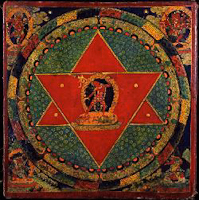| E-mail me at mcclainm@optonline.net | Visit my Facebook page | View my LinkedIn profile |

However, I am going to break mom's rule and tell you about a museum I discovered yesterday. I am not taking too much of a risk, though. Since no one other than me reads my blogs, there is little chance that anyone will discover the museum by way of this essay. Besides, it is in relatively plain sight – at the southeast corner of 17th Street and 7th Avenue in Chelsea – and was mentioned a few days ago in the New York Times.
I visited the Rubin Museum of Fine Art to see the special exhibit on Carl Jung's Red Book, but found myself drawn into (or more precisely up to) the larger collections of Himalayan art. The seven-story museum is built around a central spiral staircase which invites visitors to ever higher layers of art and artifacts from the Himalaya Mountains.
It is obvious that the museum's directors are intent on making Himalayan art as accessible as possible to Western visitors. The museum encloses the works behind glass so that visitors can view the art eyeball to eyeball; it even provides magnifying glasses so visitors can see the minute details of the compositions. Educational materials, in the form of books and digital media, are available throughout the building, Instead of shooing visitors away from the exhibits, staff offer tours. A website sponsored by the museum introduces Himalayan art to the uninitiated.
The Jung exhibit, which has been extended through February 15, 2010, celebrates the publication of Jung's Liber Novus, more commonly known as the Red Book. This fascinating tome is filled with bright, intricate mandalas and beautifully crafted calligraphic writings, the progeny of Jung's 'active imaginings'. The book itself (I almost want to say the 'ding an sich'), dubbed 'the holy grail of the unconscious' by the New York Times, is part of the display.
The exhibit includes roughly-executed precursors to the more finished drawings, many of them sketched on theater programs or other scraps of paper, as well as diaries and notebooks that became the material for the Liber Novus.
While the exhibit is illuminating by itself, it gains even greater meaning in the context of an exhibit of mandalas, five floors above. Mandalas are common symbols in Tibetan Buddhism. Representing the whole universe, they are used by Buddhist monks for meditation and other spiritual exercises.
The Rubin exhibit of mandalas will be on display through January 11. Of particular interest is a computer generated mandala produced by graphic designers at Cornell and Zurich.
If you should happen upon this blog, please feel free to visit the museum, but don't ask me where to find the blackberries.